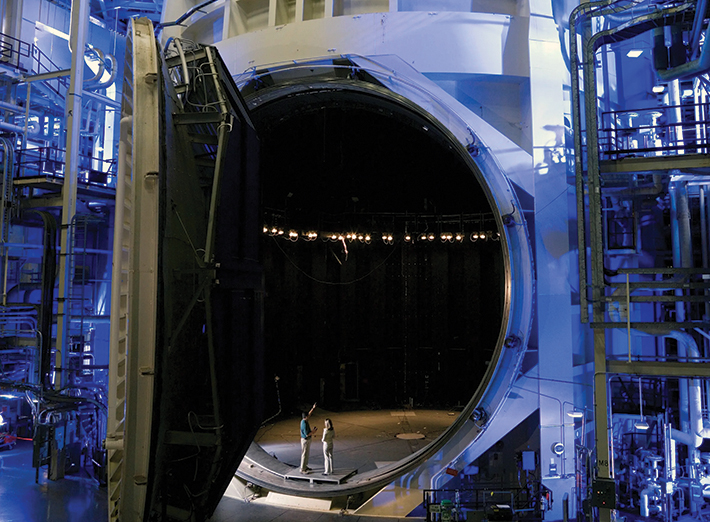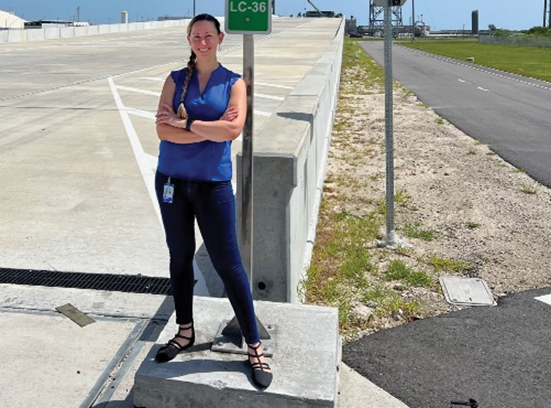
Standards for Space Simulation
Space simulation might sound like something from a sci-fi television show. But the field plays an important role in ensuring that spacecraft and components are adequately prepared for the harsh environment of space. As we enter a new space age, ASTM International’s committee on space simulation and applications of space technology (E21) is only growing in relevance. I spoke with Denisse Aranda, chair of the committee and principal contamination control engineer with Blue Origin. During our conversation, she spoke about space simulation, why it is important today, and how The X-Files’ Dana Scully inspired her to chase her dreams of working in the space industry.
Q. Can you give us an overview of what space simulation means?
A. Space simulation refers to the process of recreating the conditions of space here on Earth to test and validate spacecraft and related technologies. Space presents an extreme environment: the vacuum of space, fluctuating temperatures, atomic oxygen, and radiation are just some of the factors we must account for in the design and testing of spacecraft. On Earth, we simulate these conditions in controlled environments such as thermal vacuum chambers. These chambers remove air to replicate the vacuum of space, and we can manipulate temperatures to mimic the extreme thermal fluctuations. In our committee, we develop and refine the test methods necessary to ensure that spacecraft and their components can withstand these environments and continue to collect reliable data throughout their missions.
Q. How does the committee define the specific goals and test methods for the field?
A. The committee organizes its work into subcommittees, each focused on a particular area of space simulation. E21.04, for example, is responsible for space simulation test methods. This subcommittee develops standards for space environment simulation and applicable thermal radiation properties, including their corresponding characterization and measurement techniques.
Other subcommittees focus on areas like thermal protection (E21.08) and contamination control (E21.05), which is my specialty. Space presents unique contamination challenges. For instance, outgassing, where materials release gases under high temperatures and low pressures, can lead to the deposition of those gases on sensitive surfaces such as optics. This is particularly problematic when precision imaging or data collection is required. By addressing these issues, we ensure spacecraft can perform effectively in space’s harsh environment.
Q. What about the newest subcommittee: planetary protection (E21.09)?
A. Planetary protection encompasses efforts to prevent both forward and backward contamination. Forward contamination involves preventing Earth-based biological materials—like organisms or even human DNA—from contaminating other planets. For example, if a rover on Mars picks up traces of life, we must ensure it is not detecting Earth-originated contamination. This ensures the integrity of any scientific findings as well as protects extraterrestrial ecosystems.
Backward contamination focuses on preventing extraterrestrial microorganisms from being brought back to Earth. When we collect samples from other planets, we must handle them in clean environments to safeguard Earth from potential contaminants. This dual focus on protecting other planets and our own is critical as space exploration continues to advance.
Q. While space simulation is not quite the Star Trek holodeck many imagined, it still sounds very futuristic. Can you underscore the value and timeliness of this work?
A. The primary value of space simulation lies in protecting the integrity of our scientific endeavors. When we invest millions of dollars in payloads and instruments to explore space, ensuring the validity of the data they provide is crucial. Contaminating other planets with Earth-origin materials or misinterpreting extraterrestrial samples due to contamination would compromise these costly and groundbreaking missions.
Moreover, we are witnessing the rise of a new space age, where private and international entities are playing larger roles in space exploration. This renaissance of space exploration highlights the importance of standards like those developed by E21. As space missions increase in frequency and complexity, having universally accepted guidelines is key to ensuring that all players—whether governmental, commercial, or international—adhere to the same rigorous standards.
Q.The other part of the equation is that we are witnessing a resurgence of space exploration. The Washington Post said earlier this year that we are entering a “New Space Age.” I would guess E21’s work is only going to become more important as we scale up.
A. Absolutely. When I began my career, space exploration was largely limited to elite astronauts through NASA’s Space Shuttle program. Today, we are seeing a transformation where access to space is broadening. Companies like Blue Origin are working to democratize space travel and open opportunities for a diverse set of people to participate in space exploration.
This expansion is creating a new space economy with limitless opportunities. We are seeing the development of new jobs, the establishment of space stations for commercial use, and research being conducted in space that was previously unimaginable. Standards like those set by E21 will play a crucial role in maintaining the safety, reliability, and scientific integrity of this growing industry.
Q. What is the place for standards in this discussion, particularly as the private sector takes a more prominent role in space exploration?
A. Standards are vital in providing a common framework for all stakeholders—whether they are governmental, private, or international entities. For instance, the standard test method for total mass loss and collected volatile condensable materials from outgassing in a vacuum environment (E595) is a key standard in determining material suitability for space. This test allows engineers to measure how much gas is released from a material under vacuum conditions and how much of that gas condenses on surfaces. It’s a standard used globally, allowing for consistency in how spacecraft materials are evaluated.
As more players enter the space industry, these standards help ensure safety and mission success while also lowering costs through shared knowledge and practices. ASTM standards enable engineers and companies worldwide to collaborate and build spacecraft that meet the demands of space exploration.
Q. Can you tell us about your career? How did you get interested in working in the space industry?
A. My path to a career in space exploration has been anything but conventional. As a Hispanic immigrant from Venezuela, the idea of working in space seemed distant, yet my fascination and curiosity with the cosmos persisted. Inspired by the “Scully Effect” from The X-Files, I pursued my dreams in STEM.
I earned a B.S. in mechanical engineering from Florida International University, later obtaining a master’s degree in material science engineering from Virginia Tech. My career began with roles at NASA Langley Research Center, where I spent nearly a decade as the contamination control lead for various NASA satellites and missions, specializing in contamination control, AI&T, cleanrooms, and TVAC testing.
In 2020, I joined Blue Origin as Principal Contamination Control Engineer for the New Glenn heavy-lift rocket. My work in space exploration is continually inspired by a deep passion, driving both scientific progress and the encouragement of others to dream big.
It has been a rewarding journey, and I am honored to continue advancing space exploration through my work at Blue Origin and my leadership roles within ASTM. ■
Denisse Aranda joined Blue Origin in 2020 as the senior contamination control engineer for New Glenn heavy lift rocket. She earned the B.S. in mechanical engineering from Florida International University and the M.S. in material science engineering from Virginia Tech. Denisse worked at NASA Langley Research Center for almost a decade, where she was contamination control lead for several of NASA’s satellites (including SAGE III-ISS), science instruments, and launch vehicles, with a specialty in assembly, integration & test (AI&T), contamination control, cleanroom management, environmental testing, and thermal vacuum (TVAC) testing.

 SN Home
SN Home Archive
Archive Advertisers
Advertisers Masthead
Masthead RateCard
RateCard Subscribe
Subscribe Email Editor
Email Editor